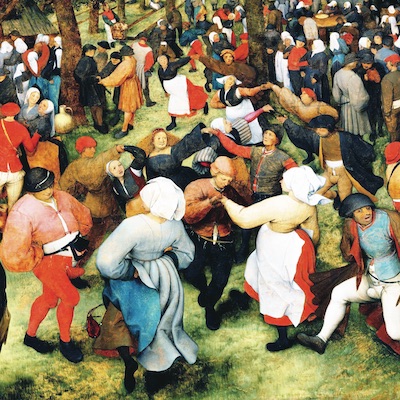-

Of the many instances of dancing mania that appeared in Europe, the longest took place in 1518 in Strasbourg, where one Frau Troffea became patient zero in a nearly two-month-long dancing spree that afflicted more than four hundred people. According to one account, the outbreak, which took place during a hot summer, killed as many as fifteen people a day.
-

Perhaps the most expensive commodity in seventeenth-century Netherlands was the Semper Augustus tulip: a single bulb is recorded to have sold for six times the cost of a ship. The now-extinct varietal’s striking appearance was the result of intentionally infecting it with tulip breaking virus, which produced dramatically striated petals but weakened and eventually destroyed the plant’s ability to reproduce.
-

After the 1774 publication of Johann Wolfgang von Goethe’s The Sorrows of Young Werther, reports surfaced of young people imitating the suicide of the novel’s protagonist. Although no deaths can be conclusively tied to so-called Werther mania, authorities from Denmark to Italy limited sales of the book as a public health measure. In Leipzig even dressing up as the character was forbidden.
-

In 2005 a virtual disease called Corrupted Blood, programmed to infect only high-level players on a specific “questline,” spiraled into a full-blown epidemic in the massively multiplayer online game World of Warcraft. Some players described seeing hundreds of characters’ bodies lying in the game’s streets. When quarantining the affected servers failed to stop the spread, administrators had no choice but to revert the entire system to an earlier version.
-

The first large-scale outbreak of a computer virus took place in 1982, when a high school student named Richard Skrenta developed Elk Cloner, a self-replicating program that would copy itself to any floppy disk inserted into an infected Apple II computer. Thereafter, every fiftieth time the machine was booted up, users were greeted with a poem composed by Skrenta: “It will get on all your disks / It will infiltrate your chips / Yes, it’s Cloner!”
-

In the 1950s and 1960s the fungal Panama disease, also known as banana wilt, wiped out most of the world’s supply of the Gros Michel banana, until that point the most popular consumer variety. That honor is now held by the bright yellow Cavendish, which accounts for 99 percent of the world’s banana consumption, though for how much longer is uncertain: a new strain of Panama disease that targets Cavendish bananas has emerged in recent decades.
-

Curators and collectors of ancient metal artifacts wage constant war against bronze disease, a fast-moving corrosion typically caused by exposure to seawater or high-salinity soil that, if left untreated, can turn bronze or copper artifacts into piles of green dust. Rumors of the contagiousness of bronze disease have persisted since the early twentieth century despite skepticism from scientists. “I have definitely seen it spread from one coin to another,” one prominent numismatist wrote in 2014.
-

According to scientists at the University of London, the relatively low impact of the 2003 SARS epidemic can be attributed to an “infection of the mind” spreading information about how to prevent the disease through face-mask use and social distancing. While five thousand SARS cases were reported in all of China during the outbreak, over 126 million text messages warning friends and family about the disease were sent in the city of Guangzhou alone.